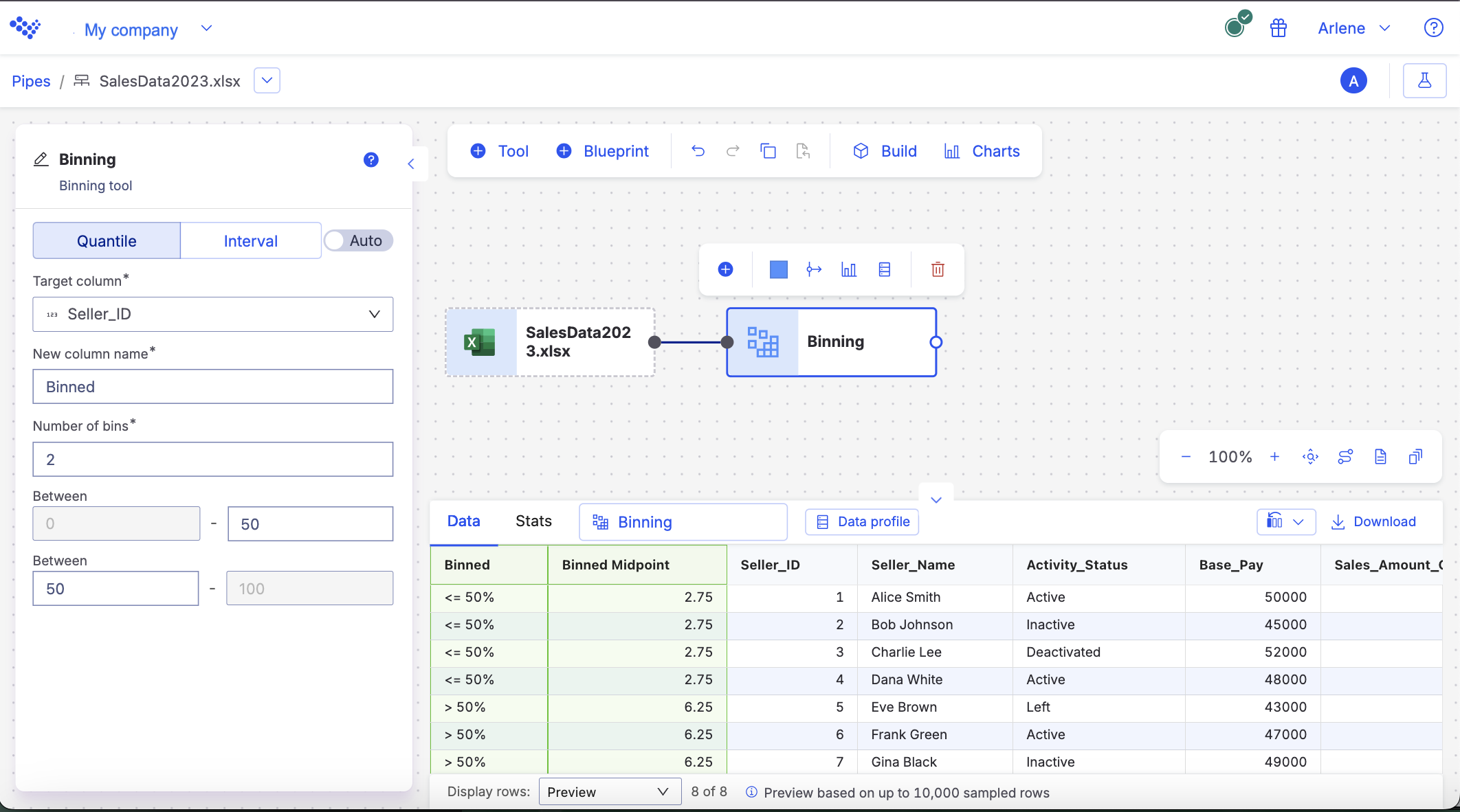Binning
Use the Binning tool to group and organize a column into categories. The Binning tool works with numeric values.
There are two ways to divide columns: quantile and interval. The Auto button automatically groups your data based on the number of specified bins. To define the bins manually, toggle the Auto button off.
Here's how the different options work:
Quantile. Equally, divide values into bins. Each bin has an equal number of records, but the value range in each bin is different. This option returns the bin and the bin midpoint.
Interval. Equally, divide a range of values into bins. The number of records in each bin varies, but the value range in each bin is the same. This option returns the bin and the bin midpoint.
Input
The Binning tool requires one data input.
Configuration
Use the following configuration options to help create your Binning configuration.
Go to the Pipes module from the side navigation bar.
From the Pipes tab, click an existing pipe to open, or create a new pipe. To create a new pipe, read the Creating a pipe documentation.
Locate the pipe you want to work with and click to open it.
In the Pipe builder, add a data source to your pipe. For more information on adding a data source, see the Data Input tool.
Click
 + Tool.
+ Tool.The Tools modal opens, where you can add tools, such as the Aggregate tool, to your pipe.
In the Tools modal, search for the Binning tool and then click + Add tool.
Tip
You can also find the Binning tool in the Organize section.
Click the tool node and drag the line to the next tool to connect the tools. If you need to undo the action, click the line and then click Unlink.
In the configuration pane, under Quantile or Interval, click to select the type of binning to divide the columns.
Quantile equally divides values into bins. Each bin has an equal number of records, but the value range in each bin is different. Returns the bin and the bin midpoint.
Interval equally divides a range of values into bins. The number of records in each bin varies, but the value range in each bin is the same. Returns the bin and the bin midpoint.
Under the Auto toggle, switch off to manually define the bins. Keep the toggle on to have the Binning tool automatically define the bins.
Under Target, select the column from your data set to organize into categories.
Under Grouped columns, select the columns to group into a single column.
Under New column name, enter the new name for your column.
For example, if you are trying to find the quarterly sales figures for each of your sellers, you could name the column, Quarterly sales.
Under Number of bins, enter the amount of bins that you need, or click the arrows to increase or decrease the number.
Click on the tool name to rename your tool node to a meaningful name. Name your tools in a way that describes the function, not the object or the data action. For example, use “Look up rate” instead of “Join to rate table”.
Usage example
Let's say you want to find out who your top and lower sellers. Using the Binning tool, you can group sellers into categories based on their sales revenue.
In the Binning configuration pane, let's configure the following values:
Click the Quantile button. Turn the Auto toggle switch off.
In the Target column field, select
SellerID.In the New column name field, enter Binned.
In the Number of bins field, enter
2.In the Between fields, enter
50in the first field and50in the second field.
Build the pipe.

The results show the sellers are grouped into two categories, >50 and <=50. This shows the sellers who are above 50% in sales, and those below 50% sales. You can now see who your top sellers are.